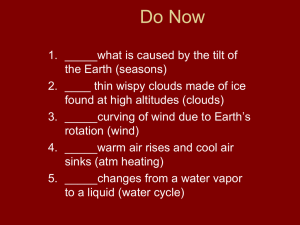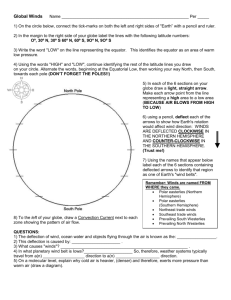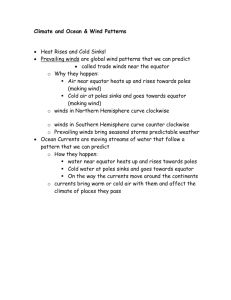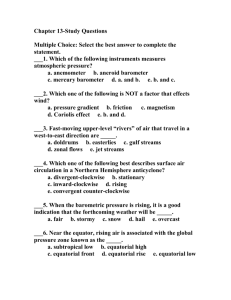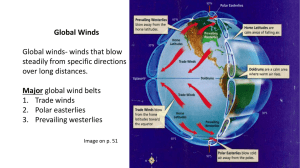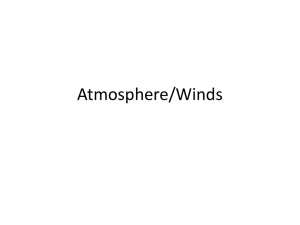Currents, Wind, and Weather
advertisement
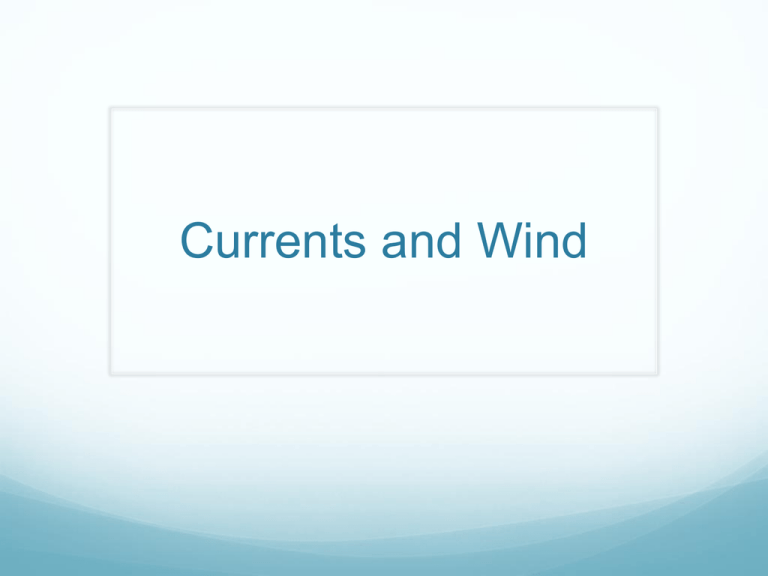
Currents and Wind The Earth is Spinning… Because Earth spins, winds and water appear to be deflected in a curved motion This is called the Coriolis Effect DON’T FORGET WE’RE TALKING ABOUT THE DEFLECTION FROM THE PERSPECTIVE OF WHERE THE OBJECT IS MOVING FROM! Look at this picture and see that in the north, the arrows curve to the right from the point of origin and to the left in the south. Which way do things not connected to Earth get deflected in the northern hemisphere? RIGHT! In the southern hemisphere? LEFT! Wind Winds drive ocean surface currents. Because wind is not connected to Earth, it is effected by the Coriolis Effect What is wind? When the sun heats the surface of Earth, the air closest to the ground also gets heated. When air is heated it becomes less dense and begins to rise. Cooler air moves into its place. This is wind. Earth’s Major Wind Patterns Most winds are named by what direction they come from. How do you think the trade winds got their name? Polar Easterlies Westerlies Trade Winds Trade Winds These helped develop trade Routes centuries ago. Westerlies Polar Easterlies Doldrums and Horse Latitudes Doldrums is defined as a boring and monotonous time. The area along the equator doesn’t have much wind, so it is called the doldrums. Sailing vessels often got stuck here for weeks because of lack of wind. Doldrums and Horse Latitudes Another area of calm air with little wind occurs along the 30 degree latitudes. Supposedly, sailing ships that got stuck here would throw horses overboard to make the ship lighter in hopes of sailing out of this calm area. Surface Currents A current is a moving fluid (liquid or gas) Winds produce currents in the ocean when they blow from the same direction for a long period of time. Ekman Transport When wind moves across water, the water moves at a 20-45° angle to the wind. That water causes the water around to move at angle to itself, and so on and so on. Eventually, there is water flowing in the opposite direction of the wind, but it is much deeper under water. On average, the water moves at a 90° angle to the wind. (To the right in the North and to the left in the south.) Gyre A gyre is a circular current formed by a combination of the rotation of the earth, prevailing winds, and land masses that interfere with the movement of water currents. Major Gyres Warm water is deflected away from the equator by wind. Cool water is deflected from the poles toward the equator by winds. Thermohaline Circulation Thermo- means heat and -haline means salt At the poles, water is very cold When the water freezes to form ice, it excludes salt, so the ice is all freshwater The water left behind is extremely salty and cold This combination makes the water very dense, so it sinks. It slowly travels along the floor of the ocean toward the equator, and warmer, less salty water flows in to replace it. This is a VERY slow process. Surface currents average 6 mph, but it is estimated that it takes 600-800 years for the entire thermohaline cycle to complete itself.
